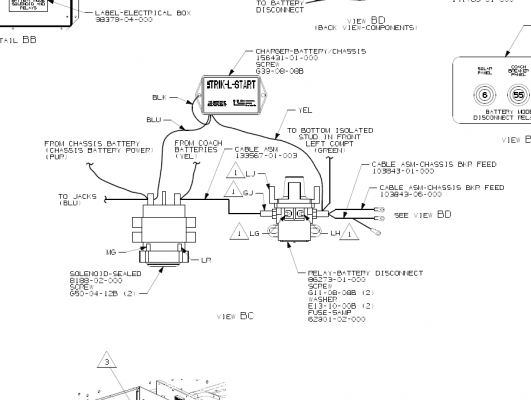Just to add, I bought a "new" 2006 Ellipse back in 2007. My "list" ended up at over 100 items, everything from the a/c non op (both dash & coach, dash air NO Freon and was missing a schrader valve AND control for the electrical condenser fan was disconnected behind the dash) cracks in the solid surface counters (replaced 3 times) cracks in the shower (at the top where it is screwed to the framing & running down 6 to 12 inches) and the little things like in-op gas furnace, water heater, water pump.... and the rig spent 10 of the first 12 months in the shop for service. The coach a/c issue I ended up fixing myself as well as the dash air (lucky I'm a contractor and EPA a/c licensed refrigeration tech) it turned out to be the freeze sensor on the evap coil was marginal in resistance and kept shutting down the system on a 3 minute cycle. (Why couldn't 3 different dealers fix this? AND freightliner charged me $100 to tell me that nothing was wrong with the a/c)
Ok, enough ranting about past problems, the one problem I have NEVER discovered a cause much less a fix to, is the 12 volt charging system. Seems Winnebago put a "annunciator" (which senses voltage) at the dash to control the charging of the house batteries. It turns on the charging circuit to the house batteries at 13.5 volts and shuts off charging at 13.0 volts. (OK, I understand this, its to keep the chassis batteries at full charge for starting and not to leave you stranded) there is a .5 volt drop between the batteries and the dash, THERE IS ANOTHER .5 VOLT DROP WHEN THE THROTTLE IS ENGAGED! Even in neutral if you bring the RPM's up to anything over 800-900 on the Cat C7, the voltage at the dash drops! The voltage at the batteries HAS to remain at over 14 volts for the system to charge. (and it doesn't) At night with the lights, in the summer, with the dash air going, maybe in the rain with the windshield wipers going..... I can always tell when it gets into its "cycle" mode (which it sometimes or should I say usually does even in the daytime) at night because the headlights are going bright / dim, bright / dim on about a 15 second cycle as the battery voltage goes 13.5 - 12.8, 3.5 - 12.8 I've had it at 2 Freightliner dealers, 3 Itasca Dealers and 2 Cat dealers, NADA on cause or fix. I must say, one Freightliner area supervisor had the maintenance department put in over 50 man hours (and they were in daily communication with Winnebago) to no avail. Usually I get the runaround (its a Winnebago problem, no its a freightliner problem, no, Cat supplied the alternator and then start over) This is another issue that freightliner charged me to say there's nothing wrong (first dealer 2 weeks after purchase)
Any Ideas????
Ok, enough ranting about past problems, the one problem I have NEVER discovered a cause much less a fix to, is the 12 volt charging system. Seems Winnebago put a "annunciator" (which senses voltage) at the dash to control the charging of the house batteries. It turns on the charging circuit to the house batteries at 13.5 volts and shuts off charging at 13.0 volts. (OK, I understand this, its to keep the chassis batteries at full charge for starting and not to leave you stranded) there is a .5 volt drop between the batteries and the dash, THERE IS ANOTHER .5 VOLT DROP WHEN THE THROTTLE IS ENGAGED! Even in neutral if you bring the RPM's up to anything over 800-900 on the Cat C7, the voltage at the dash drops! The voltage at the batteries HAS to remain at over 14 volts for the system to charge. (and it doesn't) At night with the lights, in the summer, with the dash air going, maybe in the rain with the windshield wipers going..... I can always tell when it gets into its "cycle" mode (which it sometimes or should I say usually does even in the daytime) at night because the headlights are going bright / dim, bright / dim on about a 15 second cycle as the battery voltage goes 13.5 - 12.8, 3.5 - 12.8 I've had it at 2 Freightliner dealers, 3 Itasca Dealers and 2 Cat dealers, NADA on cause or fix. I must say, one Freightliner area supervisor had the maintenance department put in over 50 man hours (and they were in daily communication with Winnebago) to no avail. Usually I get the runaround (its a Winnebago problem, no its a freightliner problem, no, Cat supplied the alternator and then start over) This is another issue that freightliner charged me to say there's nothing wrong (first dealer 2 weeks after purchase)
Any Ideas????

